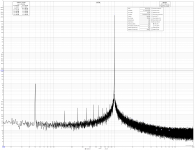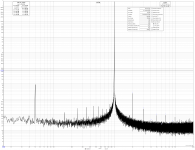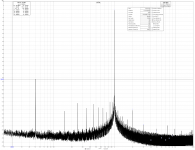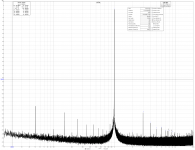Thank you. The performance of the 1kHz oscillator is limited not only by the opamp, but of course all the new boards now are coming only with the OPA1656. One of the advantages of the OPA1656 is little lower noise around the all measurement region. The LM4562/LME49720 works also very good. The reference source in these measurements is my old hand made PCB board which runs with LME49720. The schematic is the same as the new boards have. The harmonics performance of the serial boards are in -152dB...-160dB or little lower region. This old board runs on the top.Do I surmise correctly that your oscillator now uses OPA1656 in the reference trace you posted in #8033? Reference measurement without the follower before the notch-
https://content23-foto.inbox.lv/albu...lowers/Ref.jpg
Your distortion residuals are astonishing! Since it's absent in the oscillator output, the very small distortion shown in the last voltage follower trace probably arises from common-mode distortion errors? They are not present in the oscillator because the opamps are inverting?
Outstanding work!
Seems that the significant problem for to get best possible performance is the solder mask quality. Here you can see the bare PCB capacitance non linearity measurement. The two points of this board was connected in parallel with 200 kohm resistor as inverter (OPA1656) feedback. One point of the measured board is ground plane, but other is opamp inverted input (small trace):
The distortions at the beginning -
https://content23-foto.inbox.lv/albums/v/viccc/Bad-PCB/BadPCB.jpg
The groove has been cut out around the copper traces -
https://content23-foto.inbox.lv/albums/v/viccc/Bad-PCB/PCBcuttedM.jpg
Measurement at the end -
https://content23-foto.inbox.lv/albums/v/viccc/Bad-PCB/BadPCBcut.jpg
Not all the boards have that bad performance, but it is the actual problem.
Last edited:
Not yet....Did you compare those pampas when driven with a higher source impedance like 60k ?...
Yes, but SMD soldering is not so good without the mask. In the other hand, the mask can be placed only on copper surfaces, but not between them.A PCB without soldermask silver plated would not be bad.
Is it better?
Hi diyralf,
I have a paid version already. Will this install over top and use the existing license? I don't seem to have a record of the key.
The download link worked fine, thank you.
-Chris
I have a paid version already. Will this install over top and use the existing license? I don't seem to have a record of the key.
The download link worked fine, thank you.
-Chris
Here are the plots of my 1kHz Victor osc.
Only by 266mV output is max THD (-132,4) achived.
By 1V or 2V THD is significulti higher (-123.4 and 117.8),
second harmonic is to high.
Anny clue why is that so?
Powerd is by Silentswitcher ,the same is with batteries.
,the same is with batteries.
Osc. is measured direct on RTX6001 , without anny noch.
, without anny noch.
https://www.diyaudio.com/forums/attachment.php?attachmentid=796021&stc=1&d=1574165916
https://www.diyaudio.com/forums/attachment.php?attachmentid=796022&stc=1&d=1574165916
https://www.diyaudio.com/forums/attachment.php?attachmentid=796023&stc=1&d=1574165916
Only by 266mV output is max THD (-132,4) achived.
By 1V or 2V THD is significulti higher (-123.4 and 117.8),
second harmonic is to high.
Anny clue why is that so?
Powerd is by Silentswitcher
 ,the same is with batteries.
,the same is with batteries.Osc. is measured direct on RTX6001
 , without anny noch.
, without anny noch.https://www.diyaudio.com/forums/attachment.php?attachmentid=796021&stc=1&d=1574165916
https://www.diyaudio.com/forums/attachment.php?attachmentid=796022&stc=1&d=1574165916
https://www.diyaudio.com/forums/attachment.php?attachmentid=796023&stc=1&d=1574165916
Attachments
Most ADCs don't like being powered up to 0 dBFS. The distortions are not very high but interfere with the actual measurement. I would advise a measurement with notch.
Sorry, i forgot to mention RTX scale.
Measurements with 1V and 2V was done on 3,16V range of RTX, so not on 0dBFS.
That can one see on measuring diagram:
266mV - -11,5dBFS
1V - -9,8dBFS
2V - -3,9dBFS
Measurements with 1V and 2V was done on 3,16V range of RTX, so not on 0dBFS.
That can one see on measuring diagram:
266mV - -11,5dBFS
1V - -9,8dBFS
2V - -3,9dBFS
Last edited:
You might get a slightly better result at 266 mV by increasing the FFT window size, since the harmonics are buried in the noise.
At the higher levels I agree that the limitation is probably the ADC.
If you want to measure in the order of -150 dB, you will need a notch filter.
At the higher levels I agree that the limitation is probably the ADC.
If you want to measure in the order of -150 dB, you will need a notch filter.
Tnx Jens,
now I have made 1M FFT on 3,16V input range with 1V signal:
Victor osc. have shown THD -123,7 nad 2H was -123,0dB
339A osc. have THD -127,1 and 2H on -151,5dB
So, it can't be limitation of DAC
Probably is something wrong with my Victor osc.?
Any help or advice on troubleshooting will be highly appreciated.
https://www.diyaudio.com/forums/attachment.php?attachmentid=796049&stc=1&d=1574177817
https://www.diyaudio.com/forums/attachment.php?attachmentid=796050&stc=1&d=1574177817
now I have made 1M FFT on 3,16V input range with 1V signal:
Victor osc. have shown THD -123,7 nad 2H was -123,0dB
339A osc. have THD -127,1 and 2H on -151,5dB
So, it can't be limitation of DAC
Probably is something wrong with my Victor osc.?
Any help or advice on troubleshooting will be highly appreciated.
https://www.diyaudio.com/forums/attachment.php?attachmentid=796049&stc=1&d=1574177817
https://www.diyaudio.com/forums/attachment.php?attachmentid=796050&stc=1&d=1574177817
Attachments
When I mentioned the increased FFT window size I referred to the 266 mV case.
At the higher levels the harmonics were already clearly visible above the noise level.
At the higher levels the harmonics were already clearly visible above the noise level.
50 Hz noise level is a little bit too high. If you say that with batteries you have the same than it can mean that your connecting cable isn't good enough.Here are the plots of my 1kHz Victor osc
I made my cable with RG58 (RG59?) and have better picture.
Last edited:
- Home
- Design & Build
- Equipment & Tools
- Low-distortion Audio-range Oscillator




